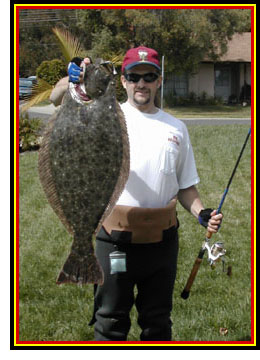 What does light
tackle, swimbaits, and a couple of hours at your local beach equal? A quick,
low-cost, hassle-free, and relatively simple way to catch quality saltwater
fish.
What does light
tackle, swimbaits, and a couple of hours at your local beach equal? A quick,
low-cost, hassle-free, and relatively simple way to catch quality saltwater
fish.Hammering Inshore Halibut
by Pete Wolf
(2002)
Introduction:
 What does light
tackle, swimbaits, and a couple of hours at your local beach equal? A quick,
low-cost, hassle-free, and relatively simple way to catch quality saltwater
fish.
What does light
tackle, swimbaits, and a couple of hours at your local beach equal? A quick,
low-cost, hassle-free, and relatively simple way to catch quality saltwater
fish.
For the purpose of this article, when I say "inshore" I am primarily talking about fishing right at the water's edge out to about 20 feet deep from the surf or small craft such as float tubes, kayaks, surfboards, skiffs, etc. Fishing for Halibut and other gamefish with artificial lures on light tackle can be extremely fun, challenging, and rewarding. I typically fish from the surf or a float tube so that is what I will focus on.
The three basic techniques I use are:
The first and probably the most important thing to remember when fishing for halibut with swimbaits is that although they live on the bottom they are not necessarily bottom feeders. They are predators and more often than not they primarily feed by sight. Although they seem to be primarily ambush hunters, they will chase, boil, and even jump clear out of the water in pursuit of prey.
Another thing to remember is that you can never fish too shallow. I have caught many legal sized halibut in extremely shallow water and have startled many more while wading in just inches of water. My largest surf halibut was caught in water that was only about 3 feet deep.
There are two basic techniques I use when fishing with swimbaits for inshore halibut. I will refer to them in this article as "subtle" and "standard". When surf fishing I primarily stick to the subtle technique. When float tubing I tend to switch between the two constantly so I always carry at least two rods - one for each technique - rigged and ready to go.
Conditions & Locations:
 Beaches
& Structure - While some beaches may be better than others I have found that nearly all beaches at one time or another will hold halibut. So I usually go to beaches that are easier to surf fish or float tube. Small surf, fewer people, and beautiful surroundings are some main draws. Coves or beaches on the lee sides of points typically offer ideal conditions for float tubing and surf fishing for halibut.
Beaches
& Structure - While some beaches may be better than others I have found that nearly all beaches at one time or another will hold halibut. So I usually go to beaches that are easier to surf fish or float tube. Small surf, fewer people, and beautiful surroundings are some main draws. Coves or beaches on the lee sides of points typically offer ideal conditions for float tubing and surf fishing for halibut.
There are basically two things to look for in a beach and each one by themselves or both together will attract fish. First - Sandy bottoms either near some kind of structure or mixed with structure. Some of the best types of structure are eel grass beds, kelp strands, and rocks. Fishing the sand "alleys" inside this type of structure can be very productive. Even variations in the bottom such as slopes or pockets can be considered structure and will attract halibut. Second - the presence of baitfish. Even beaches with almost no structure whatsoever seem to attract halibut if there is a healthy amount of baitfish.
Water Temperature - In the Santa Barbara area I have found the best inshore halibut fishing to be in the late Spring through the late fall when the water temperature is nearing the 60 degree mark and above. Warm periods during the winter season can also help draw halibut to these inshore areas. Colder water seems to cause the halibut to "hug" structure more than they do in warmer conditions. "Bass" fishing close to boiler rocks or eel grass can be very productive for finding colder water inshore halibut and perhaps other species.
Tides - I have caught successfully caught halibut at all tide periods. I have found that the effect tides have on inshore halibut has more to do with the particular beach I am fishing than the fish themselves. Some beaches fish better at lower tides and some beaches fish better at or around the high tide. There are several different beaches I fish near my home and although they are relatively close to each other some fish better around the low tide and others fish better around the high tide. This is something you will need to experiment with at the beaches you decide to fish.
Swell & Current - I prefer a balance between a minimal swell and a moderately moving current.
Subtle Technique:
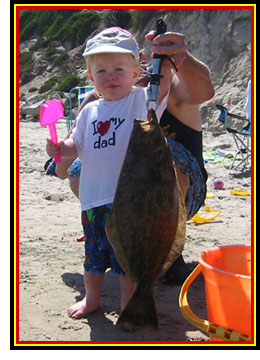 When surf fishing or shallow water float tubing for halibut I typically use what I
consider the "subtle" or "finesse" technique.
When surf fishing or shallow water float tubing for halibut I typically use what I
consider the "subtle" or "finesse" technique.
Rods - For surf fishing I prefer a lightweight sensitive graphite casting or spinning rod in the 7 to 8 foot range that has an extra-fast or fast action. The rods I currently fish are 7' 6" to 7' 9" extra-fast rod rated for 8-17 lb. test. For float tubing I prefer the same gear but rarely use a spinning rod. A lot of rod manufacturers carry rods that they market as "Plug", "Hot Shot", "Flats", or "Swim Jig" rods. These tend to be very fast action rods with strong butt sections and light tips. I find these rods have a good blend of strength and sensitivity for shallow water swimbait fishing.
Reels - For spinning I prefer a reel that is slightly larger than what is necessary for 6 or 8 lb. test. I currently use a Shimano Stradic 4000. Otherwise I use a small casting reel that can handle light lines. The Shimano Curado 200 or other low-profile "bass" reel is perfect for this technique. With a little care a good quality reel will hold up well in the harsh surf and tubing environment.
Line* - I typically use 30 lb. braid to a 15 or 20 lb. fluorocarbon leader on my casting gear and 20 lb. braid to a 12 or 15 lb. fluorocarbon leader on my spinning gear... all P-line.
Swimbait and Jig Head size - For the "subtle" technique I stick to the 3 inch Hammers with 3/16 or ¼ oz. Hammer Head jig heads.
Swimbait and Jig Head colors* - I will usually go with the "dark conditions = dark bait, light conditions = light bait" theory but am always willing to experiment. I have six compartments in the tackle tray I use... one compartment for jig heads and five for different colored swimbaits. My all around best color that seems to catch fish in any situation is Sea Wolf (#60). Since Sea Wolf is a darker opaque style bait I always bring along a light colored clear silver flake bellied such as Smelt (#106). Then there is the "white" or "pearl" bellied "category"... My favorite is Trout (#1). Then something brown & red such as Rock Critter (#14) or Pierce's Bug (#284), and finally something bright such as Invader (#40) or Cosmik Debris (#22).
Scent - I highly recommend using a bait scent - there is no reason not too. Even though I believe halibut primarily use sight when attacking a swimbait I also believe scent plays three important roles. 1) It distributes the odor of food throughout the general area you are fishing. This in turn causes the fish in the area to "get into" a feeding mood and look for food. 2) It masks "non-fishy" odors such as human oils, gasoline, sunscreen, etc. 3) It provides a "taste" for the fish once it inhales your "fake" offering. This will cause the fish to hang on to your lure longer - in the surf when you can't always feel your lure this becomes very important. When fishing for inshore halibut I use Pro-Cure Super Gels in the Sand Shrimp, Shrimp, Krill or Calico Cocktail flavors.
*Updated in 2010
Surf Fishing Techniques:
 I almost always start my retrieve as soon as the lure hits the water. Listed below are the types of retrieves that I typically use in order of preference:
I almost always start my retrieve as soon as the lure hits the water. Listed below are the types of retrieves that I typically use in order of preference:
Retrieve speed will depend on the feeding mood of the fish that particular day. I usually start of with a medium speed retrieve and vary it up with each cast until I find something that is working. From the surf I rarely let the lure hit the bottom or use a "bottom bouncing" type retrieve.
Shallow Water Float Tubing Techniques:
Like I mentioned before when float tubing I consider shallow water to be from about 7 feet deep all the way up to the shoreline. I am frequently reminded how shallow large halibut will go. Most of my retrieves are similar to the retrieves and techniques described above but in this order:
Again, the retrieve speed will depend on the feeding mood of the fish that particular day. Don't be afraid to experiment - that is the key to fishing with artificial lures.
At times (especially in clear water) this technique is an excellent way to quickly locate fish in deeper water. Since the main retrieves are constant or almost constant you can cover a lot of water quickly. At times when I'm sure the fishing will be good but not exactly sure where they may be I will scan the area quickly using this technique then switch to the "standard" technique once the fish are located.
The Strike:
With the retrieves that don't have any extra action such as the straight in grind or retrieves that have constant action such as the straight in grind while shaking the rod tip, the strike can occur at any time so be ready. With the other retrieves that strikes will usually occur just after the "action". For example, with the straight in grind and split second pauses the strike will usually occur just after one of the pauses. Detecting strikes in the surf can be difficult keeping contact with the lure and watching the line at all times will help. Sometimes halibut seem to jump off the bottom, inhale the bait, and settle back down. If you miss the actual strike it will feel like you are snagged - until the "snag" starts moving.
Standard Technique:
When float tubing in "deep" water for halibut I typically use what I call the "standard" technique. Basically this involves medium tackle and larger swimbaits. By "deep" water I am referring to water that is more than 7 feet deep.
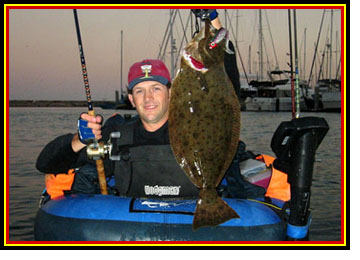 Rods - For the
standard technique I prefer a fast or extra fast action lightweight sensitive
graphite rod in the 7 to 8 foot range. A strong butt section with a fairly light
tip is important. The light tip helps detect strikes while the strong butt
section helps set the hook and fight the fish. I prefer a rod that fishes 12 to
15 lb. test well. Different companies rate rods differently so I recommend
pulling on a few before deciding on one.
Rods - For the
standard technique I prefer a fast or extra fast action lightweight sensitive
graphite rod in the 7 to 8 foot range. A strong butt section with a fairly light
tip is important. The light tip helps detect strikes while the strong butt
section helps set the hook and fight the fish. I prefer a rod that fishes 12 to
15 lb. test well. Different companies rate rods differently so I recommend
pulling on a few before deciding on one.
Reels* - I prefer a medium sized high quality casting reel. Low profile bass reels will work if they have a good drag and are properly taken care of. I use a Shimano Curado 200.
Line* - I typically use 30 or 50 lb. braid to a 20 lb. fluorocarbon leader on my casting gear and 20 lb. braid to a 15 lb. fluorocarbon leader on my spinning gear... all P-line.
Swimbait and Jig Head size - For the "standard" technique I typically use a 4 inch Hammer with a ½ or ¾ oz. Hammer Head. I try to fish as light a head as possible (while still being able to remain in contact with the bait) since I believe the slower the swimbait falls the more attractive it is to the halibut. Occasionally, if the fish are very active and aggressive I will move up to a 5½ inch (or larger) Hammer on a ¾ or 1 oz. head in an effort to weed out the smaller fish. I feel jig head color is more a matter of personal preference than anything else. I usually fish yellow or red.
Swimbait colors* - I will usually go with the "dark conditions = dark bait, light conditions = light bait" theory but never forget to experiment. I have used most of these colors with success in most conditions. Some of my favorite colors for the "standard" technique are: Trout (#1), Red Calico Hunter (#52), Sexy Smelt (#109), Green Sardine (#34), and Margarita (#33).
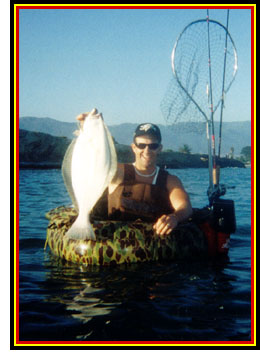 Scent - I use Pro-Cure Super Gels. Calico
Cocktail, Krill, and Sand Shrimp are some of my favorites.
Scent - I use Pro-Cure Super Gels. Calico
Cocktail, Krill, and Sand Shrimp are some of my favorites.
*Updated in 2010
The Retrieve:
After the cast keep the reel in free spool to allow the bait to sink as vertically as possible and keep your thumb on the spool to control the line and feel any strikes that may occur on the sink. When the bait hits the bottom engage the reel. Point the rod toward the bait and slightly raised (about 9:30 or 10:00 o'clock). Without moving the rod quickly crank the handle of the reel two or three times then stop and wait for the bait to hit the bottom. Again - be prepared for strikes. Repeat this retrieve all the way in. When the bait is almost straight below use the rod to bounce it on the bottom a couple of times before bringing it in for another cast.
I mentioned that I like to use as light of a jig head as possible. Sometimes trying to feel when your swimbait hits the bottom can be difficult with light jig heads. If you are having difficulty feeling when the bait hits the bottom watch your line as your swimbait sinks. When it slightly "pops" and goes slack it has hit the bottom. Watching your line is also an excellent way to detect subtle strikes.
A variation of the retrieve is to change the speed of the cranks or how fast the bait "hops" off the bottom.
There are occasions where a straight grind retrieve will produce and allow you to cover more water than with the bottom bouncing retrieve. For the straight grind retrieve choose a jig head weight that will keep the lure just off the bottom. Cast out like before and let the lure sink to the bottom. Then just wind it in at a constant speed - it can't get any easier than that!
The Strike:
Strikes usually occur at two times - on the sink or just as you begin to crank after letting it hit the bottom.
Setting the hook - You want to set the hook quickly but not immediately. What you want to do is load up the rod, and when you feel distinct pressure, set the hook. With practice you will be able to tell the difference between a fish and a snag.
Landing halibut in the surf -
If it is a legal fish and you are going to keep it you can get it in shallow and slip your hand under it's gill plate. If it's a short fish you can usually glide them in with the waves. I larger fish you plan to release can be a little more difficult. A landing device such as a BogaGrip
is the best option.
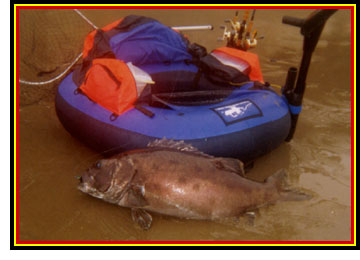 Landing halibut from the float tube - First of all, unless you are going
to keep the fish you should never use a net unless you have a fine mesh "catch
and release" type net. Regular nets will remove the fish's protective slime
coating and can cut slits in the tail. Both can lead to infection and death.
Again, the best, easiest, and safest way I have found to land a halibut from a float tube is with a landing device such as a BogaGrip.
I have heard that devices such as this can break the fish's jaw. I have only
witnessed this happening with knock off versions of the BogaGrip but have never
had it happen with the real thing.
Landing halibut from the float tube - First of all, unless you are going
to keep the fish you should never use a net unless you have a fine mesh "catch
and release" type net. Regular nets will remove the fish's protective slime
coating and can cut slits in the tail. Both can lead to infection and death.
Again, the best, easiest, and safest way I have found to land a halibut from a float tube is with a landing device such as a BogaGrip.
I have heard that devices such as this can break the fish's jaw. I have only
witnessed this happening with knock off versions of the BogaGrip but have never
had it happen with the real thing.
Conclusion:
There are many other species of fish that can be caught inshore on swimbaits
while fishing for halibut. Pleasant surprises such as white seabass, striped bass, salmon, and even
black sea bass* are not unlikely. And believe me, catching a 50+ lb. fish from a
float tube on light tackle using a swimbait is an experience you'll never
forget.
One of the most important aspects of any kind of fishing is to experiment. The techniques and retrieves mentioned in this article are meant to be guidelines offered as a place to start. Always experiment with different depths, retrieve speeds, lengths of pauses, etc. and never give up hope. No amount of information can replace confidence, experience and time on the water.
2014 Update:
After 11 years Big Hammer's new Ring Hammer swimbait has made it possible to continue fishing on days when the water is too "weedy" to fish regular swimbaits or other types of lures. The Ring Hammer is effective fished on a variety of jig heads including "Texas-rig" style offset finesse jig heads or weighted wide-gap swimbait hooks. When rigged on a jig head with the weight in front of the bait the Ring Hammer will have a more erratic side to side swimming action and when rigged on a weighted wide-gap hook (where the weight is under the belly of the bait) the Ring Hammer will have a more subtle, tight swimming action.


The Ring Hammer is also a great option when weedless is not necessary. Rigged on a larger ball head, Hammer Head, underspin head, etc. I have found the Ring Hammer to be the perfect bait when I want something larger, smellier and or noisier than the 3 inch without having to go up in jig head weight like I would if I were to use Big Hammer's 4 inch swimbait. In addition, the "rings" on the Ring Hammer hold bait scent better than regular flat surfaced swimbaits and the tail is large enough to fit a small glass rattle.
2019 Update:
When I switched from grubs to the 2" Hammer to target surfperch I discovered that halibut seem more likely to hit the 2" swimbait than the grub. Click here to read more about drop-shotting the 2" Hammer for halibut in the surf.
For more light tackle surf halibut information click here to read the article "Swimbait Halibut From The Sand" by Mike Edwards.
*The giant sea bass in the picture was released in healthy condition. According to the Department of Fish & Game it was a "clean release".
|
||
![]()
Big Hammer™, Hammer Swimbaits™, Square Tail™, Rectangular Tail™, Square Tail Design™, Rectangular Tail Design™ and the rectangular shaped swimbait tail design are all trademarks owned by Sunrize Tackle, Inc. (parent company of Big Hammer Lures). Use of these terms without written permission by Sunrize Tackle, Inc. is prohibited by law.
The photos, images, text and content of the Big Hammer™ website are copyrighted. These items and information are provided for your convenience and are only intended to be used in the positive promotion and sale of Big Hammer™ products. All other use is prohibited by law.
Big Hammer products are not intended to be used by children under 13 unless accompanied by an adult.
© Copyright Sunrize Tackle, Inc. - All Rights Reserved.